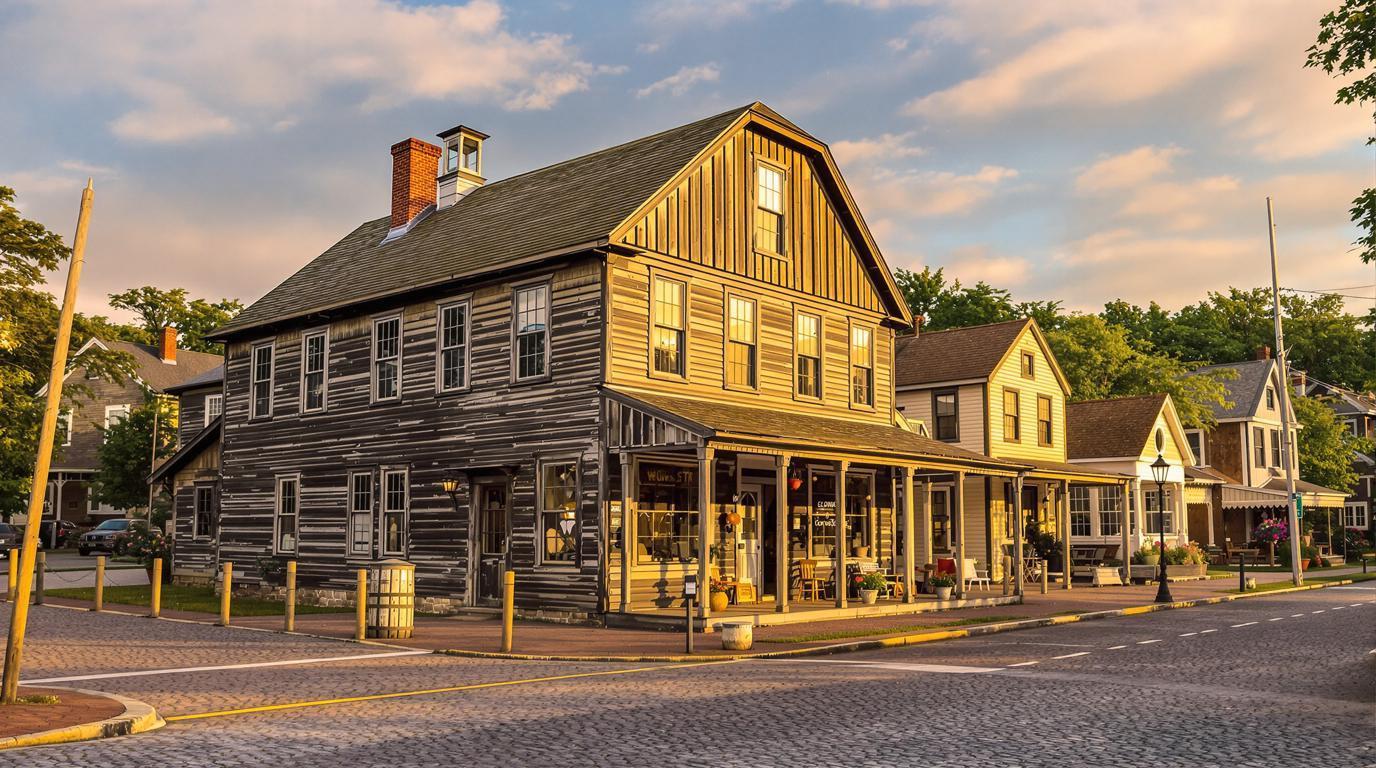Northwestern Rhode Island’s rolling hills conceal a 1,775-resident village that most New England explorers never discover. While tour buses dump thousands into Old Sturbridge Village’s reconstructed colonial theater, I found myself walking the authentic cobblestones of Chepachet, where genuine 1799 architecture stands untouched by commercial tourism. The silence here feels almost sacred—no gift shop crowds, no costumed interpreters, just the whispered stories of America’s oldest continuously operating country store.
After photographing countless New England destinations, I can confidently say that Chepachet represents something increasingly rare: a National Register Historic District that locals actually inhabit rather than perform in. This isn’t a museum village—it’s a living community where 1,775 residents maintain their heritage with quiet dignity while Sturbridge collects its $25 admission fees.
You won’t find this gem mentioned in mainstream travel guides, and that’s precisely why it matters. Princeton’s colonial sanctuary faces similar overlooked status, proving that America’s most authentic historic sites often hide in plain sight.
The 1799 architectural secret that defies tourist reconstruction
Where authentic colonial commerce never stopped
Brown and Hopkins Country Store anchors Chepachet’s historic district with a remarkable claim: established in 1809, it operates as America’s oldest continuously functioning general store. Unlike Sturbridge’s carefully curated merchant displays, this weathered wooden structure serves actual customers—locals buying hardware, visitors discovering penny candy from glass jars that predate the Civil War. The floorboards creak with two centuries of footsteps, and the hand-hewn beams show genuine tool marks from craftsmen who learned their trade before mass production existed.
The architectural integrity tourists can’t find elsewhere
Walking Chepachet’s central crossroads reveals over 50 structures contributing to its National Register status since 1971. These aren’t reconstructions—they’re survivors. Federal-style homes display original hand-forged hardware, while former mills along the Chepachet River showcase the water-powered industry that sustained this community through America’s early industrial transformation. The village layout itself tells the story: buildings positioned for stagecoach routes that connected Providence to Connecticut’s farming communities.
Hidden authenticity that mass tourism overlooks
The community preservation that commercial sites can’t replicate
Chepachet’s median household income of $103,342 reflects residents who choose historic preservation over modern convenience. These aren’t weekend hobbyists—they’re families maintaining heritage properties as primary residences. The village’s 1.92% poverty rate demonstrates economic stability that supports authentic preservation rather than tourist-dependent reconstruction. Unlike destinations that rely on admission fees, Chepachet thrives through genuine community investment.
The regional comparison that reveals hidden value
While Bethlehem’s Moravian sanctuary preserves religious heritage, Chepachet maintains secular colonial life. Both communities share similar population scales and National Register recognition, yet Chepachet’s commercial continuity offers something rarer: unbroken tradition rather than restored interpretation.
The exclusive experience locals reluctantly share
Summer access that avoids coastal crowds
Northwestern Rhode Island’s July temperatures average 75°F, offering relief from the state’s crowded beaches. Chepachet’s elevation provides natural cooling while maintaining year-round accessibility via Routes 44 and 102. The village’s position places you 45 minutes from Providence yet feels completely removed from urban pressure. This geographic advantage means comfortable exploration during peak summer months when Vermont’s Lake Champlain sanctuary offers similar temperature relief.
The insider timing that locals prefer
Early morning visits reveal Chepachet at its most authentic. The country store opens at 6 AM for local customers collecting coffee and newspapers—a ritual unchanged since the 1800s. By 8 AM, you’ll witness genuine village life: residents discussing local issues, craftspeople heading to traditional workshops, the natural rhythms of a community that functions beyond tourist schedules.
Practical access to Rhode Island’s hidden heritage
The accommodations that support authentic exploration
Chepachet’s lodging options remain deliberately limited—small inns and bed-and-breakfasts that preserve village character rather than maximize capacity. This scarcity forces advance planning but rewards visitors with genuine hospitality. Local hosts share stories impossible to find in guidebooks, connecting guests with village history through personal relationships rather than scripted presentations.
The preservation guidelines that maintain authenticity
National Register protection means Chepachet’s architecture can’t be compromised by commercial development. Building modifications require preservation approval, ensuring visual integrity remains intact. This regulatory framework protects the village’s character while allowing residents to maintain their properties as functional homes rather than museum pieces.
Northwestern Rhode Island’s 1,775-resident village proves that America’s most authentic historic experiences exist where communities live their heritage rather than perform it. While Sturbridge manufactures colonial atmosphere for paying crowds, Chepachet maintains genuine continuity that no reconstruction can replicate. The choice seems obvious: experience history where it actually happened, not where it’s been carefully recreated for tourist consumption.
Visit soon—before travel writers discover what locals have quietly preserved for over two centuries. Some treasures deserve to remain treasures, not become attractions.
Planning Your Chepachet Discovery
How far is Chepachet from major New England cities?
The village sits 45 minutes from Providence, 90 minutes from Boston, and 2 hours from Hartford. Routes 44 and 102 provide direct access without highway congestion.
When should I visit to avoid any crowds?
Early morning weekdays offer the most authentic experience. Summer months provide optimal weather, while fall brings spectacular foliage to the surrounding hills.
What makes Chepachet different from Old Sturbridge Village?
Chepachet maintains continuous operation since 1799 with residents living in historic buildings. Sturbridge recreates colonial life through interpretation and paid admission.
Are there guided tours available?
The village preserves its character through self-guided exploration. Local business owners and residents often share stories when approached respectfully.
What should I expect at Brown and Hopkins Country Store?
America’s oldest continuously operating general store functions as both historic site and working business. You can purchase items while experiencing authentic 19th-century commerce.
